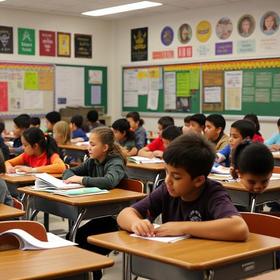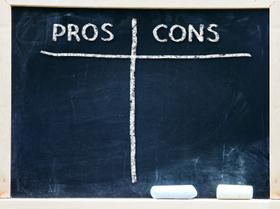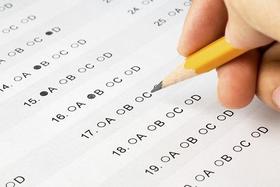The fact of the matter is that some students learn more quickly than others and some students need more individualized attention. In order to accommodate the differing needs of their students, many schools started to adopt a tracking system, separating students by academic ability into different groups for certain subjects or for all subjects. This type of program is sometimes called ability grouping (though these are technically two different things) and it is a hotly debated issue in public schools. Before you decide whether tracking might be a good option for your child, take a moment to learn what it is as well as the pros and cons of this type of system.
What is Tracking or Ability Grouping?
Also referred to as phasing or streaming, tracking is a system in which students are divided into classes based on their overall achievement. Students are ranked as being average, normal, or below average and they are divided into classes with students of the same achievement level. Tracking has been used in American public schools for nearly a century and it has changed and developed a great deal during that time. In the early years, tracking was a response to growing numbers of immigrant children coming into the public school system. The goal was to provide those children with an education that was catered to their limited understanding of the English language and their limited preparation, as compared to native students. What ended up happening, however, was a form of internal segregation within the American public school system.
Today, tracking in American public schools is less strict, in most cases, and it is often used just for certain subjects or classes, not for the entire educational system. Many secondary schools use the concept of tracking to provide different levels of difficulty for certain courses, dividing students into basic, honors, and college-preparation groups. Some schools use a variation on tracking called ability grouping which is less formal and less permanent than tracking. Ability groups are formed within individual classrooms and they never last longer than a year. They are also assigned by the teacher, not by the school system, according to the particular subject or for individual lessons. For example, during a math lesson, the teacher might divide the students into ability groups based on those who need to review basic facts before addressing the assignment and those who are ready for a more challenging assignment.
This TEDTalk makes the case for ending tracking.
The Advantages of Tracking
The fact that tracking comes in so many shapes and forms makes it difficult to determine whether it is a good or a bad thing. While tracking has been losing strength in the United States, it is an integral part of modern education in other countries such as the Netherlands. When used correctly, tracking enables the teacher to cater his lessons toward the specific ability level of the students in his class. In low and normal achievement level students, this can help to ensure that the students learn the material at their own pace without falling behind. In terms of scholastic achievement for these individuals, tracking has not been found to make a significant difference. For above-average achievers, however, tracking has been shown to produce substantial gains – students who learn more quickly are allowed to do so and they are challenged according to their ability level.
When tracking is divided by subject, it enables students to receive instruction targeted to their ability level for each subject. For example, a student who is highly gifted in math skills can attend math classes with the more advanced math students but if he has lower-level English skills, he can attend an English class that caters to that ability level. Not only does this help to ensure that students continue to learn at their own ability level, but it may also help to address the self-esteem issues that sometimes come with placing low achieving students in classrooms with high achievers. Many studies have shown that self-esteem is correlated with academic achievement so, in theory, tracking should be a system that promotes academic success. There is, however, the possibility that placing a student in a lower track could lower his self-esteem – each case is different.
This video "explores the history, practice, perils, and alternatives to grouping students for classroom instruction according to their perceived abilities".
The Disadvantages of Tracking
Though tracking systems have many potential benefits, there are also some drawbacks to consider. For example, it is not uncommon for tracking systems to encourage a sort of segregation within the school system. It has been found that many low-track classes are comprised of minority and low-income students while the upper tracks tend to be dominated by students who come from higher socioeconomic standing. During the 1980s, Jeannie Oaks brought to light a theory that many low-income and minority students were placed in lower tracks even when it wasn’t a reflection of their academic abilities. She addressed the issue of “industrial schooling”, suggesting that upper-class students received more educational opportunities while lower-income students were funneled into vocational programs and given limited educational opportunities.
Another potential disadvantage of the tracking system is that by dividing students into a group by their academic ability, the educational system may cause those students to self-label themselves as inferior to upper track students. This leads to a sort of self-fulfilling prophesy as the students experience lower self-esteem due to this separation which, in turn, can lead to reduced academic performance. There is also the fact that many students who enter ability groups or tracking systems end up staying there throughout the course of their academic career – their abilities are not always reevaluated between grades to determine whether a change needs to be made. Some detractors from the tracking system also suggest that teachers of low achieving students have lower expectations of their students and they do not provide the challenge and the drive needed to push those students to improve themselves.
This video offers an overview of educational tracking.
Additional Factors to Consider
When used properly, tracking or ability grouping in schools can be very successful but it is important to understand the limitations of this type of system. The actual composition of the tracks is very important and it is difficult to create homogenous classrooms since students inherently tend to learn at different rates, regardless of their achievement level or ability. In order to keep a tracking system working as it should, it needs to be reassessed occasionally so students can be regrouped if needed. Another factor that affects the success of a tracking program is the degree to which the curriculum is modified for each group. It is important for all students to be challenged and to be encouraged to improve, though improvement looks different for different students. It is up to the teacher to determine the proper degree to which individual students can and should be challenged to produce growth.
When it comes to the issue of tracking in schools, there is no clear right or wrong. In cases where tracking is successful, students and teachers benefit from having a more homogenous group of students – this can lead to increased educational effectiveness and higher test scores. In other cases, however, tracking may cause lower-achieving students to miss out on the opportunity to learn with (and from) higher achieving students – this can lead to increased inequality. When choosing a school for your child, it is important to consider the issue of tracking on a case-by-case basis to determine whether it is being used effectively and, if so, whether it might be a good option for your child.
Questions? Contact us on Facebook @publicschoolreview.














